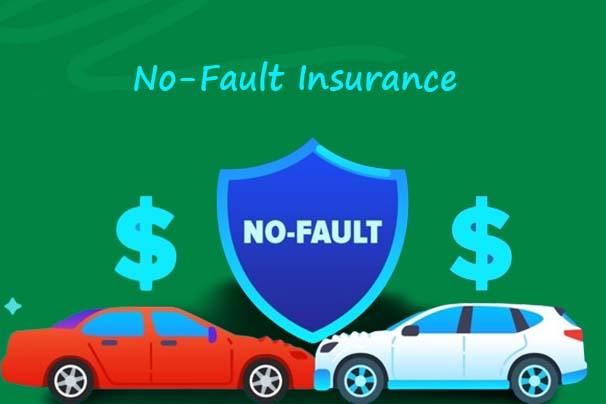In the United States, there are 14 states where no-fault insurance is mandated by law, necessitating drivers to have no-fault coverage, also known as personal injury protection (PIP). I am about to show you what PIP coverage entails, highlight potential exclusions, detail the minimum required coverage in each state, and identify leading auto insurance providers offering no-fault policies.

This insurance aims to reimburse your medical costs and lost earnings following a car accident, irrespective of who was to blame. While some states mandate the possession of no-fault auto insurance by drivers, in others, it remains optional coverage. Often, no-fault insurance is synonymous with personal injury protection, or PIP.
What is No-Fault Insurance?
No-fault insurance represents a form of auto insurance whereby the insurer compensates the policyholder for losses, regardless of who caused the accident. This system is designed to facilitate and expedite compensation. Thereby, eliminating the need for policyholders to establish the fault of the other party to be reimbursed for injuries.
Additionally, this insurance usually provides coverage for medical costs, lost wages, and other essential and justifiable expenses incurred as a result of injuries from the accident. It is important to note that this insurance does not cover property damage, such as damage to vehicles. Or personal property; those claims are still based on determining who was at fault in the accident.
Additionally, no-fault insurance is not available in all states. States that do offer this insurance have varying rules and coverage limits. In some cases, policyholders may have the option to sue for severe injuries or damages that exceed a certain threshold.
How Does it Work?
Imagine you are involved in a car accident with another vehicle, leading to minor injuries for both you and the other motorist. In states that mandate this insurance, you would submit a claim to your insurance provider to cover your medical bills. While the other party would do the same with their insurer. The responsibility for the accident is irrelevant under no-fault insurance, eliminating the necessity to pursue a claim through the other driver’s insurance.
The specifics of personal injury protection coverage can differ significantly across states. For example, in Kansas, which is one of the 12 states that require no-fault insurance, the law demands a minimum PIP coverage of $4,500. Meanwhile, in Michigan, another state with no-fault insurance laws, the minimum required PIP coverage is significantly higher at $50,000.
Should you or any passengers sustain serious injuries in an accident and decide to file a lawsuit against the other driver for compensation, specific criteria must be met. Your medical costs must surpass a certain financial threshold, or the injuries must meet a specific level of seriousness, such as resulting in disability, disfigurement, or death, to proceed with a lawsuit.
These criteria, known as either a monetary limit or a verbal threshold, vary by state. States like Hawaii, Kansas, Kentucky, Massachusetts, Minnesota, North Dakota, and Utah opt for a monetary threshold, while the remaining five no-fault states adhere to a verbal threshold, as outlined by the Insurance Information Institute (III).
What Does No-Fault insurance cover?
Here are the situations that no-fault insurance, also known as personal injury protection (PIP), typically covers:
- Medical Expenses: Expenses for medical treatment, care, and rehabilitation resulting from an accident.
- Lost Income: Reimbursement for earnings lost as a result of being unable to work after an accident.
- Funeral Expenses: For fatal incidents, PIP can include costs for funeral and burial services.
- Substitute Services: Costs for necessary services that you’re unable to undertake due to injuries, like cleaning services.
- Survivor’s Loss: Monetary support for dependents of an individual who has passed away in a vehicular accident, encompassing lost wages and essential services.
What Does It Not Cover?
No-fault insurance does not cover:
- Property Damage: Damage to vehicles or personal property; this is typically covered by collision or comprehensive insurance.
- Injuries to the Other Driver: Your PIP only covers your injuries; the other driver would rely on their own PIP coverage.
- Pain and Suffering: No-fault insurance does not cover non-economic damages like pain and suffering unless the case meets “serious injury” thresholds that allow you to sue the at-fault driver.
How much does no-fault insurance cost?
The price of no-fault insurance can differ greatly depending on a variety of factors, such as your state of residence, driving history, the coverage amount you select, and the insurance provider you choose. Annual premiums may fall anywhere between several hundred and several thousand dollars. To obtain an accurate cost estimate, it is advised to request a quote from an insurance provider within your state.
Here are other factors that affect the cost of this type of insurance:
- Gender.
- Marital Status.
- Age.
- Vehicle details
How to Get No-Fault Insurance
If you are considering purchasing a no-fault insurance policy, here are the basic steps you need to take to acquire one, even though the process differs by insurance provider:
Research your state’s requirements:
Investigate whether your state mandates no-fault insurance and familiarize yourself with the required minimum coverage levels.
Compare Quotes:
Look for and evaluate quotes from various insurers that provide PIP or no-fault coverage within your state.
Assess Your Needs:
Reflect on your financial circumstances and decide how much coverage you need beyond what is required by your state.
Apply for Coverage:
After selecting an insurance provider, you typically have the option to apply online, via phone, or in person.
Provide Necessary Information:
Be prepared to supply personal details, information about your car, and your driving record.
Review your policy
Ensure you thoroughly check your policy upon receipt to confirm it matches your requirements. And also that you fully understand the extent of your coverage.
In conclusion, obtaining no-fault insurance can be a simple process, yet it is essential to secure sufficient coverage to safeguard your finances in case of an accident.
